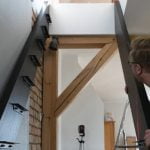Home improvement is a staple for homeowners and property owners alike, as it is essential for maintaining and enhancing the value of one’s property. But what vertical does home improvement fall under? In this article, we will explore the construction industry and its relation to home improvement, as well as its economic, legal, environmental, and technological impact.
When it comes to home improvement, it encompasses a wide range of activities aimed at making a residence more comfortable, functional, and aesthetically pleasing. From minor repairs to major renovations, home improvement projects can vary in scale and complexity. The importance of home improvement cannot be overstated, as it not only enhances the quality of life for occupants but also contributes to the overall value of the property.
In the following sections, we will delve into the economic impact of home improvement, examining data and statistics that showcase its significance in various markets. We will also explore the legal and regulatory landscape surrounding home improvement projects, including permits, zoning requirements, and building codes that play a crucial role in ensuring safety and compliance.
Additionally, we will examine popular trends in home improvement, from DIY endeavors to professional services sought by homeowners. Stay tuned as we uncover the multifaceted nature of home improvement within the construction industry.
The Economic Impact of Home Improvement
Home improvement falls under the construction industry vertical, which is a significant sector that contributes to the overall economy. The construction industry encompasses various areas such as residential, commercial, and industrial construction, with home improvement being a key aspect of the residential construction sector.
According to data from the National Association of Home Builders (NAHB), home improvement and repair expenditures in the United States reached approximately $407 billion in 2019. This demonstrates the substantial economic impact of home improvement activities within the construction industry. Furthermore, the Bureau of Labor Statistics reported that employment in the construction industry is projected to grow 4% from 2019 to 2029, indicating the continued significance of this vertical.
In addition to its direct economic impact, home improvement also stimulates other related industries such as building materials manufacturing, retail, and professional services. For instance, the demand for sustainable and energy-efficient materials in home improvement projects has led to innovation and growth within the green building and renewable energy sectors. Therefore, it is evident that home improvement plays an integral role within the broader construction industry vertical, influencing economic growth and innovation across various sectors.
- Construction industry includes residential, commercial, and industrial sectors
- Home improvement is a key aspect of residential construction
- NAHB reported $407 billion spent on home improvement in 2019
- Bureau of Labor Statistics projects 4% employment growth in construction industry from 2019 to 2029
- Home improvement stimulates related industries such as building materials manufacturing and professional services
The Legal and Regulatory Landscape
Permits: Navigating the Requirements
Home improvement projects often require various permits from local government authorities. These permits ensure that the work being done complies with building codes, zoning regulations, and other legal requirements. The specific permits needed depend on the nature of the project, whether it involves structural changes, electrical work, plumbing, or other alterations to the home. Understanding and obtaining the necessary permits is crucial to avoid legal issues and ensure the safety and quality of the improvements.
Zoning Regulations: Adhering to Local Laws
Zoning regulations dictate how land can be used in specific areas, including residential zones where home improvement projects are carried out. These regulations may impact factors such as property setbacks, building heights, lot coverage, and restrictions on certain types of structures or uses. Homeowners must adhere to these zoning laws when planning and executing home improvement projects to avoid costly violations or delays in construction.
Building Codes Compliance: Ensuring Safety and Quality
Building codes are a set of regulations that specify standards for construction methods, materials, and safety. Compliance with these codes is essential to ensure that home improvement projects meet minimum requirements for structural integrity, fire safety, energy efficiency, and other important aspects. Failure to adhere to building codes can result in hazardous conditions within the home and legal consequences for non-compliance.
Navigating the legal and regulatory landscape of permits, zoning regulations, and building codes is an integral part of any home improvement project. Homeowners should consult with professionals or local authorities to understand the specific requirements for their area before embarking on any renovations or upgrades. By complying with these regulatory aspects, homeowners can ensure that their home improvement projects are not only legally sound but also safe and of high quality.
What Vertical Does Home Improvement Fall Under
Defining Vertical
When it comes to home improvement, it is important to understand the vertical in which it falls. The term “vertical” refers to a specific industry or market sector within an economy. In the case of home improvement, it falls under the construction industry vertical. This means that home improvement projects are categorized as part of the larger construction sector, which encompasses a wide range of activities related to building, renovating, and maintaining structures.
Home Improvement and Construction Industry Relationship
The relationship between home improvement and the construction industry is significant, as both share similar processes and principles. The construction industry involves planning, designing, financing, building, and maintaining physical structures such as residential buildings, commercial facilities, and infrastructure. Similarly, home improvement projects also involve planning and designing renovations or upgrades to existing structures.
Furthermore, the construction industry provides various services and products that are vital for home improvement projects. These include specialized contractors for tasks such as carpentry, plumbing, electrical work, HVAC installation, roofing, and more. Additionally, the construction industry supplies materials such as lumber, concrete, metal fabrication products, insulation products, and other essential components needed for home improvement.
Growth Opportunities Within the Construction Industry
As part of the construction industry vertical, home improvement presents significant growth opportunities. With an increasing demand for housing and infrastructure improvements globally, the construction industry is poised for substantial growth in the coming years. Home improvement projects contribute to this growth by driving demand for skilled laborers and innovative technologies that enhance efficiency and sustainability within the construction sector.
Overall, understanding that home improvement falls under the construction industry vertical highlights its significance within a broader economic context while emphasizing its role in driving innovation and growth within this sector.
Popular Trends in Home Improvement
When it comes to home improvement, there are various popular trends that homeowners and contractors alike are embracing. One of the most significant trends in recent years is the rise of do-it-yourself (DIY) projects.
Many individuals are choosing to take on home improvement tasks themselves, whether it’s painting a room, installing new fixtures, or even renovating entire spaces. This trend has been fueled by the abundance of online tutorials and resources, making it easier for people to learn new skills and tackle projects on their own.
On the other end of the spectrum, professional home improvement services continue to be in high demand. While some may enjoy DIY projects, others prefer to hire skilled professionals to ensure high-quality results. From general contractors to specialized tradespeople such as plumbers and electricians, the professional home improvement industry remains a cornerstone of the market. With busy schedules and complex projects, many homeowners opt for the expertise and convenience that comes with hiring professionals.
Another notable trend is the increasing focus on sustainable and eco-friendly home improvement practices. As awareness of environmental issues grows, more individuals are seeking out energy-efficient appliances, environmentally friendly building materials, and sustainable design principles for their home improvement projects.
This shift towards sustainability reflects a broader societal emphasis on reducing our carbon footprint and creating more eco-conscious living spaces. These trends within the home improvement industry not only reflect changing consumer preferences but also have a significant impact on the construction vertical as a whole.
The Environmental Impact of Home Improvement
Home improvement projects can have a significant environmental impact, making it important to consider sustainable practices and materials. By choosing eco-friendly options for home improvement, individuals can reduce their carbon footprint and contribute to conservation efforts. Here are some key factors to consider when aiming to make home improvement more environmentally friendly:
- Energy-efficient appliances and fixtures: When undergoing renovations, homeowners should consider investing in energy-efficient appliances and fixtures. This can lead to lower overall energy consumption and reduced utility bills.
- Use of sustainable materials: Opting for sustainable materials such as reclaimed wood, bamboo flooring, or recycled glass countertops can help minimize the environmental impact of home improvement projects.
- Water conservation: Implementing water-saving features such as low-flow toilets, faucets, and showerheads can help reduce water usage within the home. Additionally, landscaping with drought-resistant plants can contribute to water conservation efforts.
In addition to these considerations, proper waste management during home improvement projects is crucial for minimizing environmental impact. This includes recycling construction waste whenever possible and ensuring that hazardous materials are disposed of safely. By incorporating these sustainable practices into home improvement projects, individuals can make a positive environmental impact while enhancing their living spaces.
Furthermore, homeowners may also want to explore opportunities for renewable energy sources as part of their home improvement efforts. Installing solar panels or utilizing geothermal heating systems are just a couple of examples of how homeowners can reduce their reliance on traditional energy sources and decrease their environmental footprint. As society continues to prioritize sustainability, integrating eco-friendly practices into home improvement will likely become even more prevalent in the future.
The Role of Technology in Home Improvement
Home improvement falls under the construction industry vertical. The construction industry encompasses a wide range of activities, including the building, renovation, and maintenance of structures such as residential homes, commercial buildings, and infrastructure projects. Home improvement specifically focuses on the enhancement, modification, or repair of residential properties to improve their functionality, aesthetics, and value.
According to the U.S. Census Bureau, spending on home improvements reached an estimated $420 billion in 2020 alone. This significant investment not only stimulates economic growth but also creates job opportunities and drives innovation within the construction sector. As technology continues to advance, smart homes have become a prominent trend in home improvement. Smart home devices and systems are revolutionizing how homeowners interact with their living spaces, from automated lighting and climate control to sophisticated security features.
The integration of technology in home improvement aligns with the broader shift towards sustainable practices and energy-efficient materials. Innovations such as solar panels, energy-saving appliances, and eco-friendly building materials are increasingly being incorporated into home improvement projects to reduce environmental impact and promote long-term sustainability.
| Category | Data |
|---|---|
| Total Spending on Home Improvements (2020) | $420 billion |
| Projected Growth of Smart Home Market (2022-2027) | 18% |
| Percentage of Homeowners Using Energy-Efficient Materials in Renovations | 56% |
The Future of Home Improvement
As the home improvement industry continues to grow and evolve, it is essential to look into the future of this market segment. Predicting the trends and understanding the market growth can help businesses and consumers make informed decisions about their home improvement projects.
One significant prediction for the future of home improvement is the increasing adoption of smart home technology. From automated lighting and security systems to thermostats and appliances that can be controlled remotely, smart home technology is expected to become a standard feature in many households.
Market growth in the home improvement industry is also expected to be driven by sustainable practices and materials. Consumers are becoming more environmentally conscious, leading to a demand for eco-friendly products and services. This trend is likely to continue in the coming years, with an increasing number of homeowners opting for energy-efficient solutions, recycled materials, and sustainable building practices.
Furthermore, as more millennials become homeowners, there will be a shift towards modern and minimalist design trends. This demographic values simplicity, functionality, and sustainability, which will influence the direction of home improvement projects. Market research indicates that millennials are willing to invest in high-quality products that offer durability and long-term value.
| Prediction | Market Growth |
|---|---|
| Increasing adoption of smart home technology | Driven by sustainable practices and materials |
| Shift towards modern and minimalist design trends influenced by Millenials | Value simplicity, functionality, sustainability |
Conclusion
In conclusion, home improvement plays a significant role within the construction vertical. It not only contributes to the economic growth of the construction industry but also has a substantial impact on the overall housing market. Home improvement projects create jobs, stimulate economic activity, and ultimately contribute to the growth and stability of the construction sector.
Furthermore, as seen in the article, home improvement is subject to various legal and regulatory considerations such as permits, zoning, and building codes. These regulations ensure that home improvement projects are carried out in a safe and compliant manner, thereby contributing to the overall integrity of the construction industry.
With technology advancements and a growing emphasis on sustainable practices and materials, the future of home improvement within the construction vertical looks promising. The integration of smart home technology and innovative building materials will continue to shape the way home improvement is carried out, further cementing its importance within the wider construction industry. As such, it is clear that home improvement is an integral part of the construction vertical, with far-reaching economic, social, and environmental implications.

I’m thrilled to have you here as a part of the Remodeling Top community. This is where my journey as an architect and remodeling enthusiast intersects with your passion for transforming houses into dream homes.





